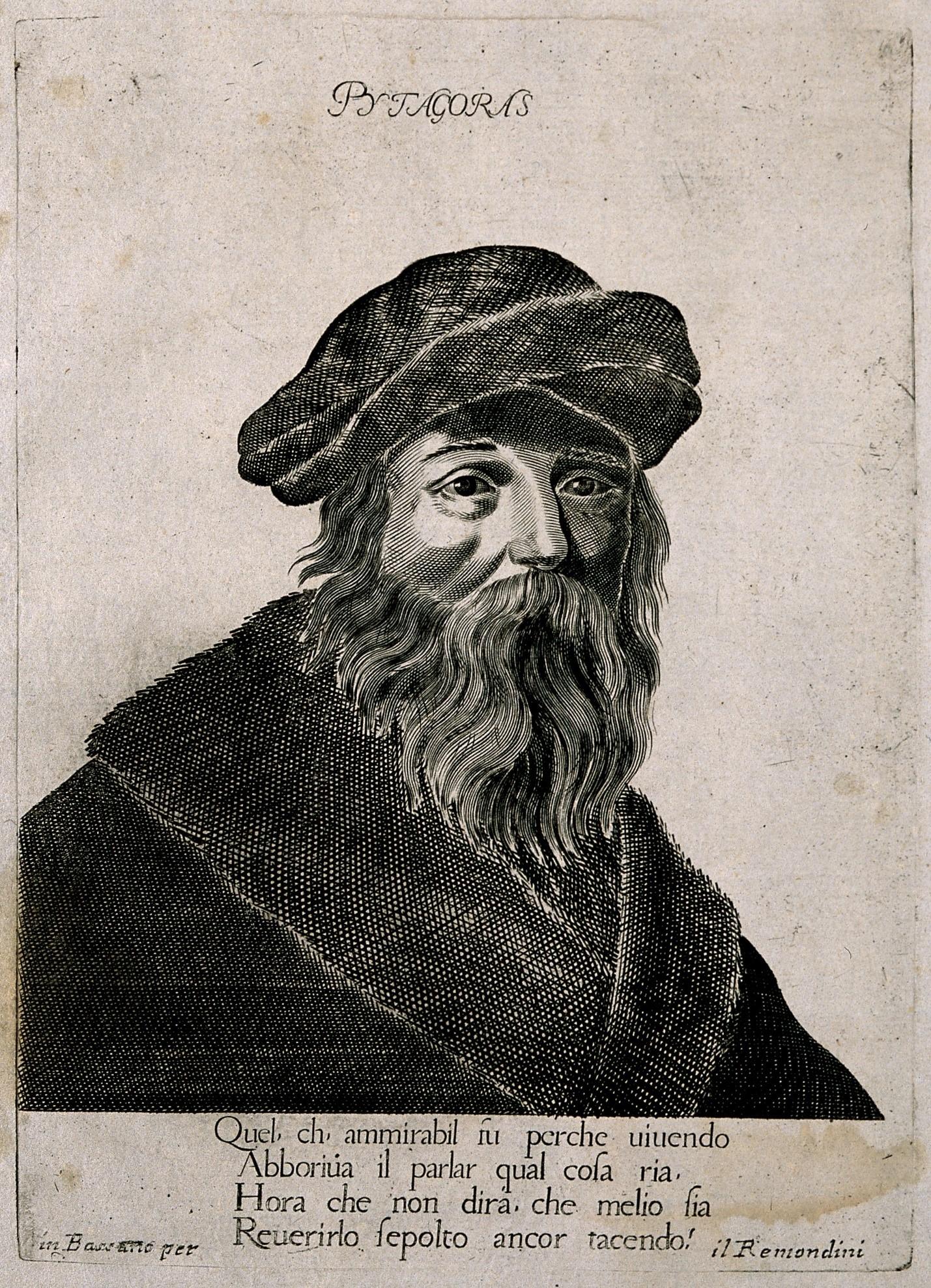School curricula, across the globe, undergo regular revisions, as governments and their education departments strive to adapt to changing times, interests and the needs of their political agenda, learners and the economy. Notwithstanding, there are some concepts that remain constant in the mathematics curriculum, despite all the changes; one of them being a number of concepts unearthed and developed by the ‘mathematics great’, Pythagoras.
Although he is mostly known for the theorem of Pythagoras, there is evidence of his genius in numerous other mathematical concepts: arithmetic, cosines, fractions, geometry, reciprocals, square roots, symmetry, tangent and trigonometry.

Pythagoras: His Early Life
Pythagoras was born on Samos, a Greek island in the Aegean Sea, around 570 BCE. While he is regarded as one of the greatest mathematicians of ancient times, elements of his life have not been proven beyond doubt, since there are very few surviving written records of his era. There are biographies of Pythagoras’ life, but these were written well after his death.
Legend has it that an oracle had predicted that a gifted child would be born to Pythagoras’ father and, thus, the name Pythagoras was chosen, implying “announced by Pythian.” Indeed, Pythagoras turned out to be a very gifted child. At the young age of eighteen, he participated in the Olympic games of combat and won all of his bouts. Intellectual and athletic, as a scholar he was interested in Greek philosophy, the sciences and history. Also, as pointed out by some historian, he became a student of Thales, another eminent mathematician.

Continuing his studies, the Greek mathematician and philosopher undertook a series of journeys that eventually led him to Egypt. There, he spent time learning, under the tutelage of Egyptian priests, until he was taken prisoner by the invading Persian army and taken to Babylon in 525 BCE. There, he immersed himself in the knowledge of the Babylonian scribes. On his return home (the island of Samos), he started teaching in an amphitheatre, with little success. It is actually true that his attempts to spread the knowledge, he had gained, led to him being banished from the city. He made up his mind to flee to mainland Greece with the aim of establishing a school, giving lectures and carrying on in the tradition of the great Greek philosophers. As he had always done, he made it a priority to apply maths to philosophical thought. A good many of his students followed him, his teachings and research so diligently that some commentators posited that he had started a sect rather than a school. The circumstances around his death, around 500 BCE, again, are not well documented.
The Pythagorean Theorem’s History
Pythagoras has been a blight on the existence of many a high-schooler, with many having a hard time to make sense of the Pythagorean theorem, his most seminal concept. In truth, it was actually not discovered by him. Clay tablets, which date back to 1800 BCE, show that the properties and lengths of triangles were well-known to Babylonians, long before Pythagoras was born. However, the theorem of Pythagoras is ascribed to him because he was the first person to express it in the way that people still learn it today:
“The square on the hypotenuse is equal to the sum of the squares on the other two sides”. It can be calculated thus: a2 + b2 = c2.
This applies to all right-angled triangles and the hypotenuse is the longest side and the side opposite to the right angle. Nowadays it’s quite easy to find the length of the hypotenuse by using an online hypotenuse calculator.
Having worked out this particular law cemented Pythagoras’ place in the history of mathematics. He did, however, still have to prove his theory and numerous experiments had to be performed do that. This work, performed by at the school he had established, inspired other mathematical greats like Sir Isaac Newton and , before him, Leonardo de Vinci.

It is also possible to show the theorem thus, without using numbers:
“The sum of the squares of the lengths of a right triangle are equal to the square of its hypotenuse.”
Knowledge of the formula allows one to calculate the length of one side of a right triangle and also to prove whether a triangle is a right triangle. Known as the Converse of Pythagoras, it states: “if the square of the longest side is equal to the sum of the squares of the two other sides, the triangle is a right triangle.”
Pythagoras’ theorem, which is still taught today, has led to the development of a particular type of geometry, referred to as Euclidean geometry.
Given the importance of a strong foundation in mathematics for academic and future career success, it might be beneficial to hire an online maths tutor. An experienced tutor can offer personalized instruction, tailored to individual learning styles and needs, which can greatly enhance understanding of complex concepts, improve problem-solving skills, and boost overall confidence in the subject. This tailored support can make a significant difference in achieving academic goals and building a solid math foundation
Pythagoras’ Other Significant Discoveries
Pythagoras was not only a genius at mathematics. He believed that mathematicians should also make an effort to learn other subjects, such as astronomy, music, mysticism and philosophy. He and his followers practised this way of thinking and, together, managed make quite a number of mathematical discoveries. Very importantly, Pythagoras discovered the link between the pitch of the note played on a string and the length of that particular vibrating string. He took his interest in music a bit further. He experimented with water-filled glasses and discovered that each glass played a different musical note, depending on how much water it contained.
Pythagoras’ research formed the basis of investigation for many other mathematicians and researchers, including Rene Descartes. His discoveries in mathematics continued to filter through into other fields of study and took on many forms. Below follow an assortment of his discoveries.
The Pythagorean Spiral (or Snail) is a tool which allows on to geometrically visualise the square roots of consecutive whole numbers. The spiral starts off with a right angle being drawn, with the sides of the triangle equal to 1.
Using the hypotenuse of the first triangle, a second triangle is drawn, starting off with a right angle on the hypotenuse. The spiral continues with each new triangle being drawn on the hypotenuse of the preceding one and using a base length of 1 for each one. Making use of this tool, as well as the concept of right angles, we can calculate the square roots of whole numbers which equal the lengths of right-angled triangles hypotenuses.
The Pythagorean Table of Opposites is one that is used to teach multiplication tables to children and adults. It’s really a very simple table consisting of two columns. Values, which are entered into the left column, can then be added, multiplied or divided to provide a value in the column on the right.
Consider hiring a math tutor to learn more about Pythagoras and his foundational contributions to early mathematical theory.
The Place of the School of Pythagoras in Mathematics
Pythagoras’ goal in life was always to teach mathematics and he enjoyed the support of a group of people, who assisted him with his scientific studies. For that reason, he established the School of Pythagoras at Cortana in the south of Italy. Although some alluded to it as a sect, the members, at this school, aimed at becoming astute politicians and philosophers; and even dabbled a bit in religion. Generally speaking, mathematics was always the centre of Pythagoras’ life.

Numbers were the centre of all things for the staff of this school. They, along with Pythagoras, sustained their interest in the divisibility of numbers, which led them to famously proclaim: “numbers rule the universe.” Lasting for 150 years, the school was home to 218 members, known as Pythagoreans.
Because most work was executed in teams, it very difficult to pinpoint who exactly was responsible for any particular principle or formula, ascribed to the Pythagorean school.
Their emphasis was on the study of associated numbers, perfect numbers and sacred numbers, the latter being particularly appreciated by the members at Pythagoras’ school.
The Pythagoreans invested specific numbers with mystical properties, the number 1 symbolised unity and the origin of all things, since all other numbers can be created from 1 by adding enough copies of it. For example, 7 = 1+1+1+1+1+1+1.- Brittanica.com
Seven was also highly regarded in Israelite and eastern culture and literature. It was said to communicate a sense of “completeness” or fulness”, Seven is spelled used using the same consonants as the word “???“ which means full/complete. This gives significance to the repeated use of the number seven in the Bible.
The number 10 also had a special significance, since it could represent the sum of the first three prime numbers or the sum of a pair of squared prime numbers, among other combinations.
Some people, at that time, regarded Pythagoras and his disciples as magicians, mainly because they had found a way to trace a regular pentagon, a figure which has five equal sides. The figure they drew or designed, they adopted as their symbol.
Sadly, the School of Pythagoras broke up because of a dispute amongst members of two political factions, within the school. Pythagoras and his school played a pivotal role in the development of mathematics. A raft of mathematical concepts – addition, conjecture, circumferences, decimals, fragment, quadrilaterals, parallelogram, perpendicular, relative numbers, scale products, sine, whole numbers – all owe their discovery to this great mathematician.
Calculating the hypotenuse of a right-angle triangle should present no further problems to you. No matter the length of the sides, punch in the measurements and (Voila!), an online hypotenuse calculator works out exactly how long the hypotenuse is.















